*NURSING > HESI MED SURG > Medical-surgical-nursing-nclex-questions (All)
Medical-surgical-nursing-nclex-questions
Document Content and Description Below
1. A female client is admitted with a diagnosis of acute renal failure. She is awake, alert, oriented, and complaining of severe back pain, nausea and vomiting and abdominal cramps. Her vital signs ... are blood pressure 100/70 mm Hg, pulse 110, respirations 30, and oral temperature 100.4°F (38°C). Her electrolytes are sodium 120 mEq/L, potassium 5.2 mEq/L; her urinary output for the first 8 hours is 50 ml. The client is displaying signs of which electrolyte imbalance? A. Hyponatremia B. Hyperkalemia C. Hyperphosphatemia D. Hypercalcemia 2. Assessing the laboratory findings, which result would the nurse most likely expect to find in a client with chronic renal failure? A. BUN 10 to 30 mg/dl, potassium 4.0 mEq/L, creatinine 0.5 to 1.5 mg/dl B. Decreased serum calcium, blood pH 7.2, potassium 6.5 mEq/L C. BUN 15 mg/dl, increased serum calcium, creatinine l.0 mg/dl D. BUN 35 to 40 mg/dl, potassium 3.5 mEq/L, pH 7.35, decreased serum calcium 3. Treatment with hemodialysis is ordered for a client and an external shunt is created. Which nursing action would be of highest priority with regard to the external shunt? A. Heparinize it daily. B. Avoid taking blood pressure measurements or blood samples from the affected arm. C. Change the Silastic tube daily. D. Instruct the client not to use the affected arm. 4. Romeo Diaz, age 78, is admitted to the hospital with the diagnosis of benign prostatic hyperplasia (BPH). He is scheduled for a transurethral resection of the prostate (TURP). It would be inappropriate to include which of the following points in the preoperative teaching? A. TURP is the most common operation for BPH. B. Explain the purpose and function of a two-way irrigation system. C. Expect bloody urine, which will clear as healing takes place. D. He will be pain free. 5. Roxy is admitted to the hospital with a possible diagnosis of appendicitis. On physical examination, the nurse should be looking for tenderness on palpation at McBurney‟s point, which is located in the A. left lower quadrant B. left upper quadrant C. right lower quadrant D. right upper quadrant 6. Mr. Valdez has undergone surgical repair of his inguinal hernia. Discharge teaching should include A. telling him to avoid heavy lifting for 4 to 6 weeks B. instructing him to have a soft bland diet for two weeks C. telling him to resume his previous daily activities without limitations D. recommending him to drink eight glasses of water daily 7. A 30-year-old homemaker fell asleep while smoking a cigarette. She sustained severe burns of the face,neck, anterior chest, and both arms and hands. Using the rule of nines, which is the best estimate of total body-surface area burned? A. 18% B. 22% C. 31% D. 40% 8. Nursing care planning is based on the knowledge that the first 24-48 hours post-burn are characterized by: A. An increase in the total volume of intracranial plasma B. Excessive renal perfusion with diuresis C. Fluid shift from interstitial space D. Fluid shift from intravascular space to the interstitial space 9. If a client has severe bums on the upper torso, which item would be a primary concern? A. Debriding and covering the wounds B. Administering antibiotics C. Frequently observing for hoarseness, stridor, and dyspnea D. Establishing a patent IV line for fluid replacement 10. Contractures are among the most serious long-term complications of severe burns. If a burn is located on the upper torso, which nursing measure would be least effective to help prevent contractures? A. Changing the location of the bed or the TV set, or both, daily B. Encouraging the client to chew gum and blow up balloons C. Avoiding the use of a pillow for sleep, or placing the head in a position of hyperextension D. Helping the client to rest in the position of maximal comfort 11. An adult is receiving Total Parenteral Nutrition (TPN). Which of the following assessment is essential? A. evaluation of the peripheral IV site B. confirmation that the tube is in the stomach C. assess the bowel sound D. fluid and electrolyte monitoring 12. Which drug would be least effective in lowering a client‟s serum potassium level? A. Glucose and insulin B. Polystyrene sulfonate (Kayexalate) C. Calcium glucomite D. Aluminum hydroxide 13. A nurse is directed to administer a hypotonic intravenous solution. Looking at the following labeled solutions, she should choose A. 0.45% NaCl B. 0.9% NaCl C. D5W D. D5NSS 14. A patient is hemorrhaging from multiple trauma sites. The nurse expects that compensatory mechanisms associated with hypovolemia would cause all of the following symptoms EXCEPT A. hypertension B. oliguria C. tachycardia D. tachypnea 15. Maria Sison, 40 years old, single, was admitted to the hospital with a diagnosis of Breast Cancer. She was scheduled for radical mastectomy. Nursing care during the preoperative period should consist of A. assuring Maria that she will be cured of cancer B. assessing Maria‟s expectations and doubts C. maintaining a cheerful and optimistic environment D. keeping Maria‟s visitors to a minimum so she can have time for herself 16. Maria refuses to acknowledge that her breast was removed. She believes that her breast is intact under the dressing. The nurse should A. call the MD to change the dressing so Kathy can see the incision B. recognize that Kathy is experiencing denial, a normal stage of the grieving process C. reinforce Kathy‟s belief for several days until her body can adjust to stress of surgery. D. remind Kathy that she needs to accept her diagnosis so that she can begin rehabilitation exercises. 17. A chemotherapeutic agent 5FU is ordered as an adjunct measure to surgery. Which of the ff. statements about chemotherapy is true? A. it is a local treatment affecting only tumor cells B. it affects both normal and tumor cells C. it has been proven as a complete cure for cancer D. it is often used as a palliative measure. 18. Which is an incorrect statement pertaining to the following procedures for cancer diagnostics? A. Biopsy is the removal of suspicious tissue and the only definitive method to diagnose cancer B. Ultrasonography detects tissue density changes difficult to observe by X-ray via sound waves. C. CT scanning uses magnetic fields and radio frequencies to provide crosssectional view of tumor D. Endoscopy provides direct view of a body cavity to detect abnormality. 19. A post-operative complication of mastectomy is lymphedema. This can be prevented by A. ensuring patency of wound drainage tube B. placing the arm on the affected side in a dependent position C. restricting movement of the affected arm D. frequently elevating the arm of the affected side above the level of the heart. 20. Which statement by the client indicates to the nurse that the patient understands precautions necessary during internal radiation therapy for cancer of the cervix? A. “I should get out of bed and walk around in my room.” B. “My 7 year old twins should not come to visit me while I‟m receiving treatment.” C. “I will try not to cough, because the force might make me expel the application.” D. “I know that my primary nurse has to wear one of those badges like the people in the x-ray department, but they are not necessary for anyone else who comes in here.” 21. High uric acid levels may develop in clients who are receiving chemotherapy. This is caused by: A. The inability of the kidneys to excrete the drug metabolites B. Rapid cell catabolism C. Toxic effect of the antibiotic that are given concurrently D. The altered blood ph from the acid medium of the drugs 22. Which of the following interventions would be included in the care of plan in a client with cervical implant? A. Frequent ambulation B. Unlimited visitors C. Low residue diet D. Vaginal irrigation every shift 23. Which nursing measure would avoid constriction on the affected arm immediately after mastectomy? A. Avoid BP measurement and constricting clothing on the affected arm B. Active range of motion exercises of the arms once a day. C. Discourage feeding, washing or combing with the affected arm D. Place the affected arm in a dependent position, below the level of the heart 24. A client suffering from acute renal failure has an unexpected increase in urinary output to 150ml/hr. The nurse assesses that the client has entered the second phase of acute renal failure. Nursing actions throughout this phase include observation for signs and symptoms of A. Hypervolemia, hypokalemia, and hypernatremia. B. Hypervolemia, hyperkalemia, and hypernatremia. C. Hypovolemia, wide fluctuations in serum sodium and potassium levels. D. Hypovolemia, no fluctuation in serum sodium and potassium levels. 25. An adult has just been brought in by ambulance after a motor vehicle accident. When assessing the client, the nurse would expect which of the following manifestations could have resulted from sympathetic nervous system stimulation? A. A rapid pulse and increased RR B. Decreased physiologic functioning C. Rigid posture and altered perceptual focus D. Increased awareness and attention 26. Ms. Sy undergoes surgery and the abdominal aortic aneurysm is resected and replaced with a graft. When she arrives in the RR she is still in shock. The nurse‟s priority should be : A. placing her in a trendeleburg position B. putting several warm blankets on her C. monitoring her hourly urine output D. assessing her VS especially her RR 27. A major goal for the client during the first 48 hours after a severe bum is to prevent hypovolemic shock. The best indicator of adequate fluid balance during this period is A. Elevated hematocrit levels. B. Urine output of 30 to 50 ml/hr. C. Change in level of consciousness. D. Estimate of fluid loss through the burn eschar. 28. A thoracentesis is performed on a chest-injured client, and no fluid or air is found. Blood and fluids is administered intravenously (IV), but the client‟s vital signs do not improve. A central venous pressure line is inserted, and the initial reading is 20 cm H^O. The most likely cause of these findings is which of the following? A. Spontaneous pneumothorax B. Ruptured diaphragm C. Hemothorax D. Pericardial tamponade 29. Intervention for a pt. who has swallowed a Muriatic Acid includes all of the following except; A. administering an irritant that will stimulate vomiting B. aspirating secretions from the pharynx if respirations are affected C. neutralizing the chemical D. washing the esophagus with large volumes of water via gastric lavage 30. Which initial nursing assessment finding would best indicate that a client has been successfully resuscitated after a cardio-respiratory arrest? A. Skin warm and dry B. Pupils equal and react to light C. Palpable carotid pulse D. Positive Babinski‟s reflex 31. Chemical burn of the eye are treated with A. local anesthetics and antibacterial drops for 24 – 36 hrs. B. hot compresses applied at 15-minute intervals C. Flushing of the lids, conjunctiva and cornea with tap or preferably sterile water D. cleansing the conjunctiva with a small cotton-tipped applicator 32. The Heimlich maneuver (abdominal thrust), for acute airway obstruction, attempts to: A. Force air out of the lungs B. Increase systemic circulation C. Induce emptying of the stomach D. Put pressure on the apex of the heart 33. John, 16 years old, is brought to the ER after a vehicular accident. He is pronounced dead on arrival. When his parents arrive at the hospital, the nurse should: A. ask them to stay in the waiting area until she can spend time alone with them B. speak to both parents together and encourage them to support each other and express their emotions freely C. Speak to one parent at a time so that each can ventilate feelings of loss without upsetting the other D. ask the MD to medicate the parents so they can stay calm to deal with their son‟s death. 34. An emergency treatment for an acute asthmatic attack is Adrenaline 1:1000 given hypodermically. This is given to: A. increase BP B. decrease mucosal swelling C. relax the bronchial smooth muscle D. decrease bronchial secretions 35. A nurse is performing CPR on an adult patient. When performing chest compressions, the nurse understands the correct hand placement is located over the A. upper half of the sternum B. upper third of the sternum C. lower half of the sternum D. lower third of the sternum 36. The nurse is performing an eye examination on an elderly client. The client states „My vision is blurred, and I don‟t easily see clearly when I get into a dark room.” The nurse best response is: A. “You should be grateful you are not blind.” B. “As one ages, visual changes are noted as part of degenerative changes. This is normal.” C. “You should rest your eyes frequently.” D. “You maybe able to improve you vision if you move slowly.” 37. Which of the following activities is not encouraged in a patient after an eye surgery? A. sneezing, coughing and blowing the nose B. straining to have a bowel movement C. wearing tight shirt collars D. sexual intercourse 38. Which of the following indicates poor practice in communicating with a hearing-impaired client? A. Use appropriate hand motions B. Keep hands and other objects away from your mouth when talking to the client C. Speak clearly in a loud voice or shout to be heard D. Converse in a quiet room with minimal distractions 39. A client is to undergo lumbar puncture. Which is least important information about LP? A. Specimens obtained should be labeled in their proper sequence. B. It may be used to inject air, dye or drugs into the spinal canal. C. Assess movements and sensation in the lower extremities after the D. Force fluids before and after the procedure. 40. A client diagnosed with cerebral thrombosis is scheduled for cerebral angiography. Nursing care of the client includes the following EXCEPT A. Inform the client that a warm, flushed feeling and a salty taste may be B. Maintain pressure dressing over the site of puncture and check for C. Check pulse, color and temperature of the extremity distal to the site of D. Kept the extremity used as puncture site flexed to prevent bleeding. 41. Which is considered as the earliest sign of increased ICP that the nurse should closely observed for? A. abnormal respiratory pattern B. rising systolic and widening pulse pressure C. contralateral hemiparesis and ipsilateral dilation of the pupils D. progression from restlessness to confusion and disorientation to lethargy 42. Which is irrelevant in the pharmacologic management of a client with CVA? A. Osmotic diuretics and corticosteroids are given to decrease cerebral edema B. Anticonvulsants are given to prevent seizures C. Thrombolytics are most useful within three hours of an occlusive CVA D. Aspirin is used in the acute management of a completed stroke. 43. What would be the MOST therapeutic nursing action when a client‟s expressive aphasia is severe? A. Anticipate the client wishes so she will not need to talk B. Communicate by means of questions that can be answered by the client shaking the head C. Keep us a steady flow rank to minimize silence D. Encourage the client to speak at every possible opportunity. 44. A client with head injury is confused, drowsy and has unequal pupils. Which of the following nursing diagnosis is most important at this time? A. altered level of cognitive function B. high risk for injury C. altered cerebral tissue perfusion D. sensory perceptual alteration 45. Which nursing diagnosis is of the highest priority when caring for a client with myasthenia gravis? A. Pain B. High risk for injury related to muscle weakness C. Ineffective coping related to illness D. Ineffective airway clearance related to muscle weakness 46. The client has clear drainage from the nose and ears after a head injury. How can the nurse determine if the drainage is CSF? A. Measure the ph of the fluid B. Measure the specific gravity of the fluid C. Test for glucose D. Test for chlorides 47. The nurse includes the important measures for stump care in the teaching plan for a client with an amputation. Which measure would be excluded from the teaching plan? A. Wash, dry, and inspect the stump daily. B. Treat superficial abrasions and blisters promptly. C. Apply a "shrinker" bandage with tighter arms around the proximal end of the affected limb. D. Toughen the stump by pushing it against a progressively harder substance (e.g., pillow on a foot-stool). 48. A 70-year-old female comes to the clinic for a routine checkup. She is 5 feet 4 inches tall and weighs 180 pounds. Her major complaint is pain in her joints. She is retired and has had to give up her volunteer work because of her discomfort. She was told her diagnosis was osteoarthritis about 5 years ago. Which would be excluded from the clinical pathway for this client? A. Decrease the calorie count of her daily diet. B. Take warm baths when arising. C. Slide items across the floor rather than lift them. D. Place items so that it is necessary to bend or stretch to reach them. 49. A client is admitted from the emergency department with severe-pain and edema in the right foot. His diagnosis is gouty arthritis. When developing a plan of care, which action would have the highest priority? A. Apply hot compresses to the affected joints. B. Stress the importance of maintaining good posture to prevent deformities. C. Administer salicylates to minimize the inflammatory reaction. D. Ensure an intake of at least 3000 ml of fluid per day. 50. A client had a laminectomy and spinal fusion yesterday. Which statement is to be excluded from your plan of care? A. Before log rolling, place a pillow under the client‟s head and a pillow between the client‟s legs. B. Before log rolling, remove the pillow from under the client‟s head and use no pillows between the client‟s legs. C. Keep the knees slightly flexed while the client is lying in a semi-Fowler‟s position in bed. D. Keep a pillow under the client‟s head as needed for comfort [Show More]
Last updated: 1 year ago
Preview 1 out of 18 pages

Reviews( 0 )
Document information
Connected school, study & course
About the document
Uploaded On
Mar 26, 2021
Number of pages
18
Written in
Additional information
This document has been written for:
Uploaded
Mar 26, 2021
Downloads
0
Views
54

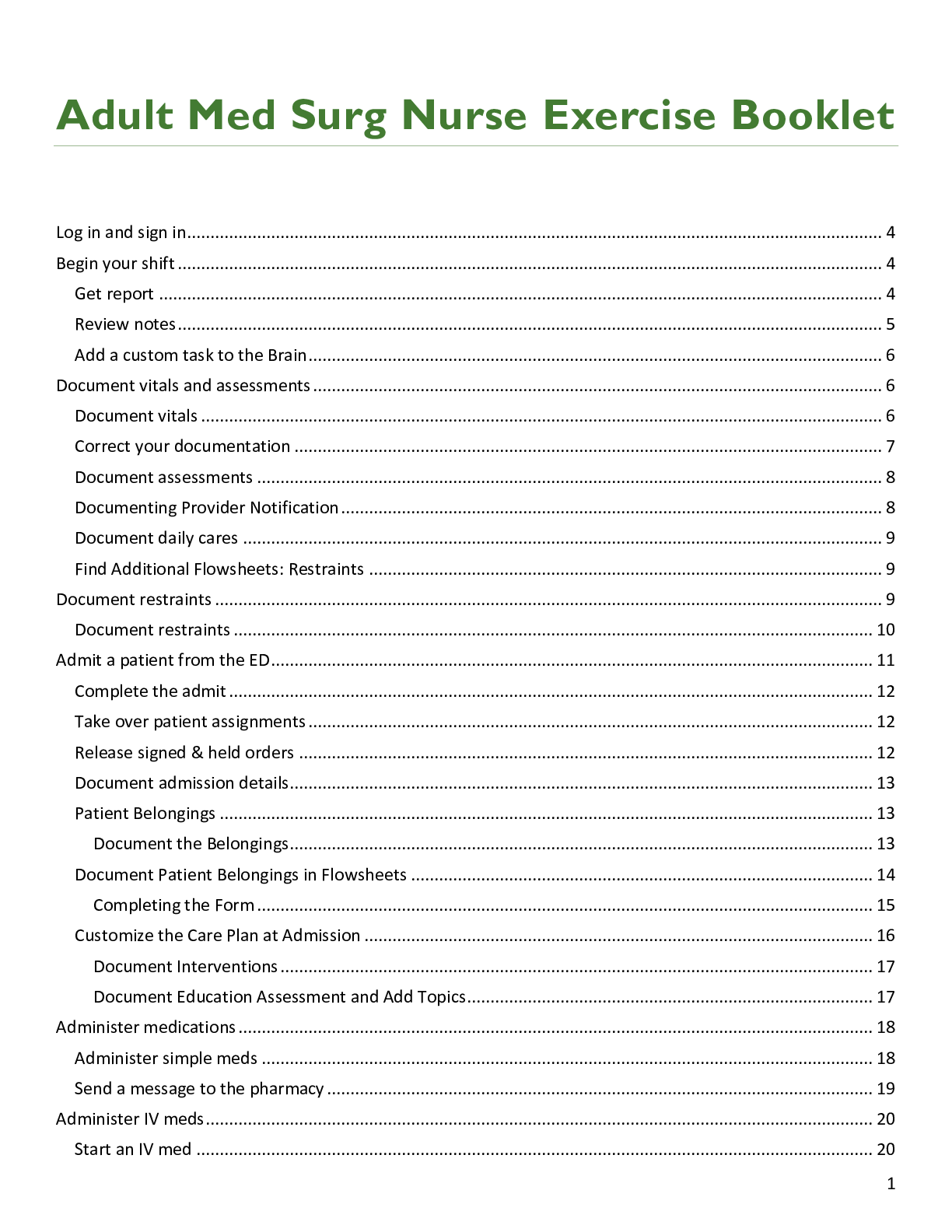


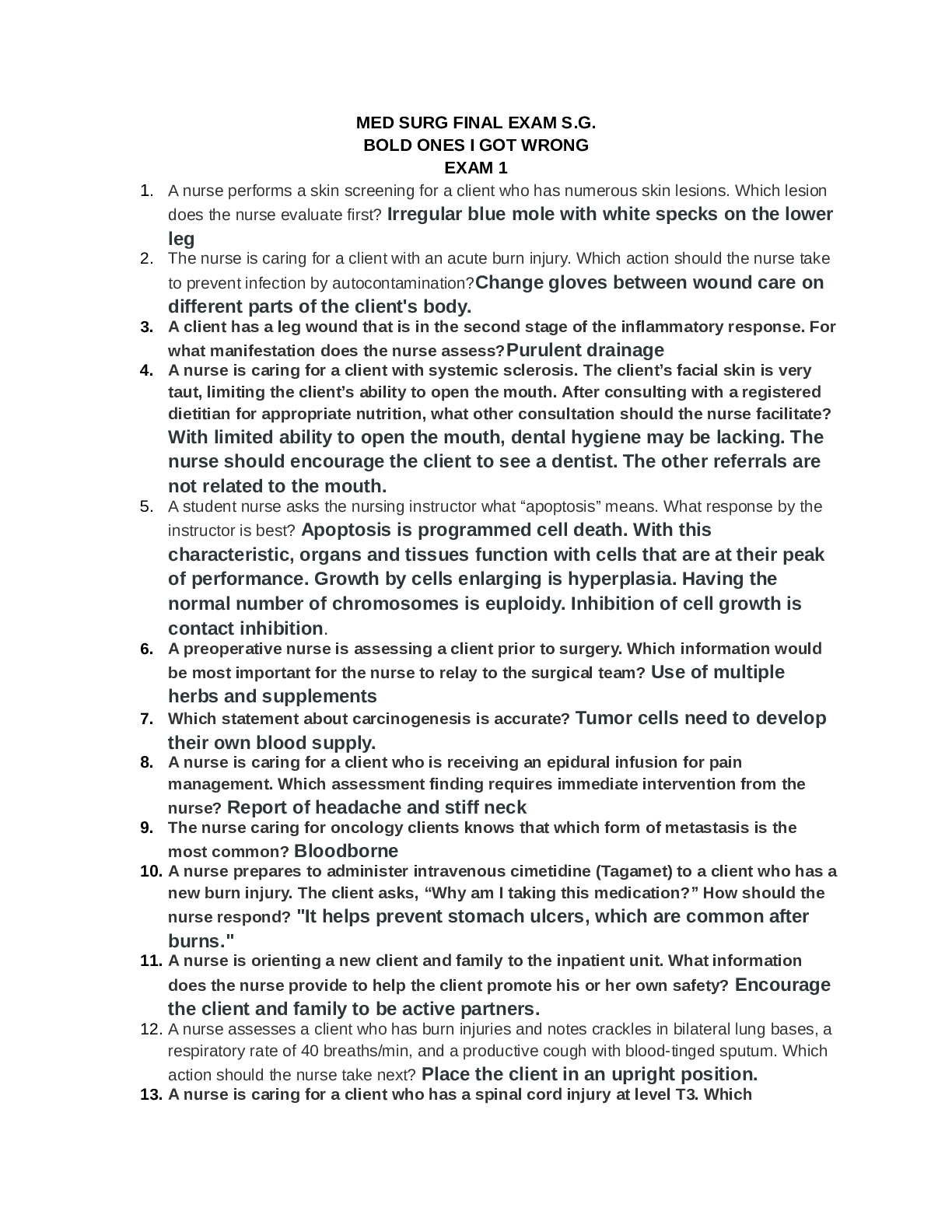
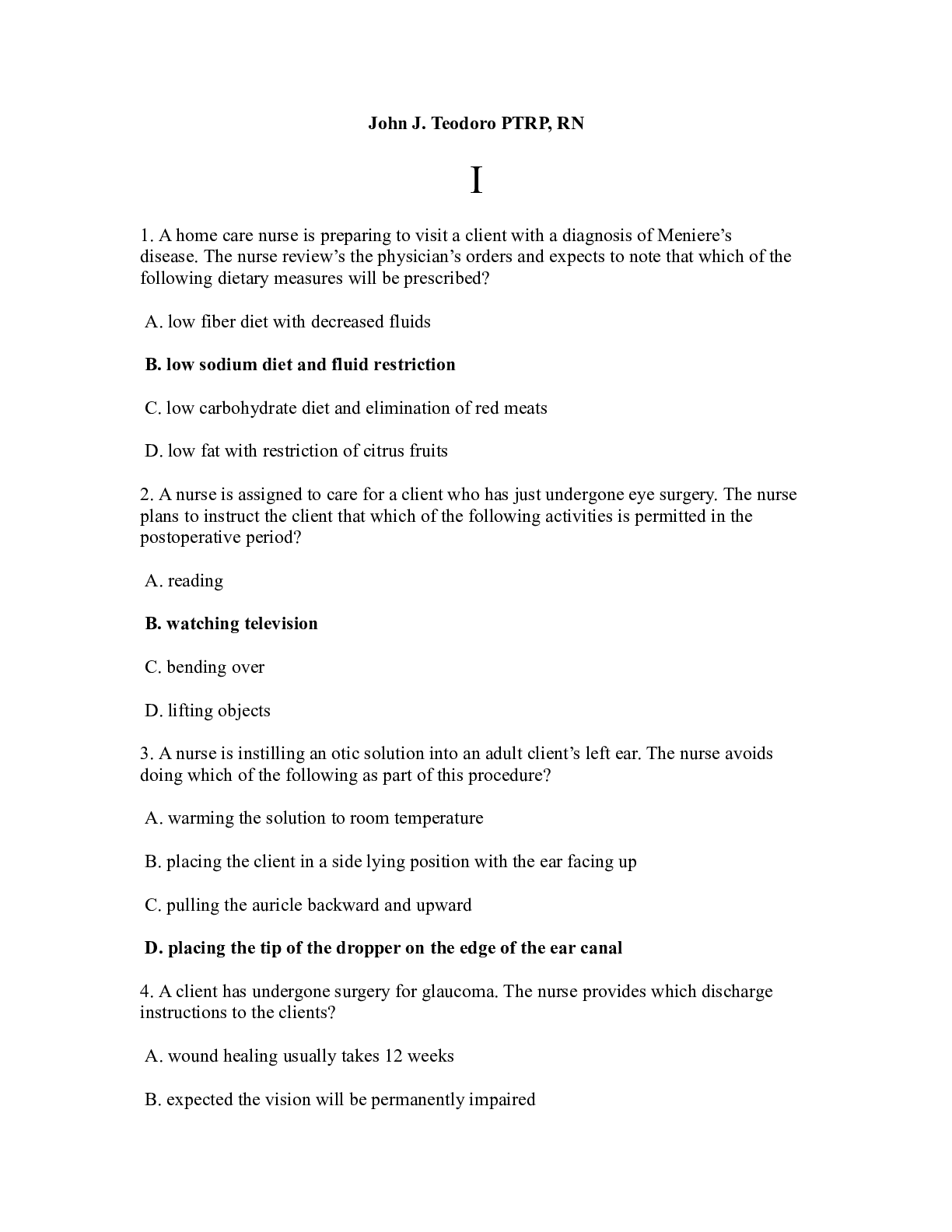

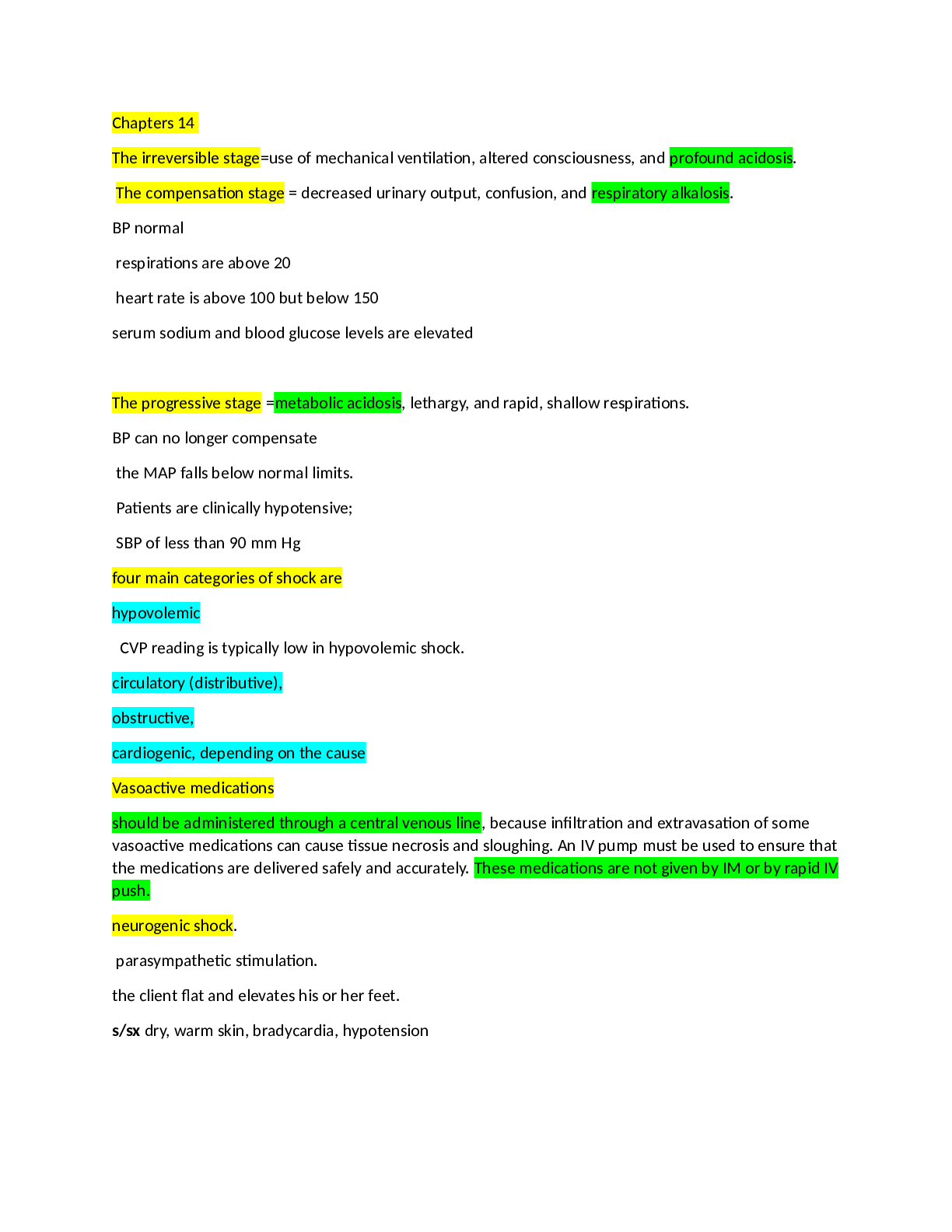
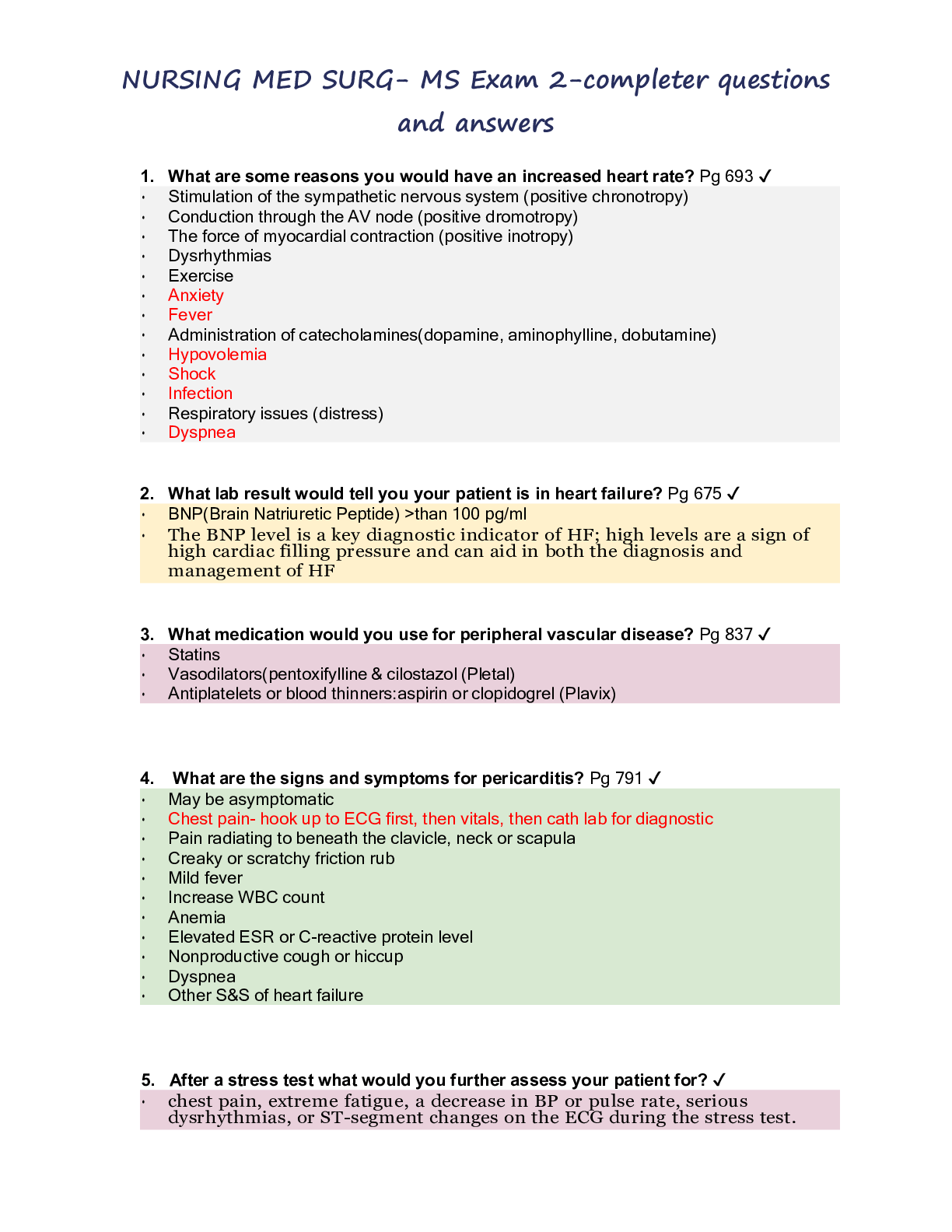
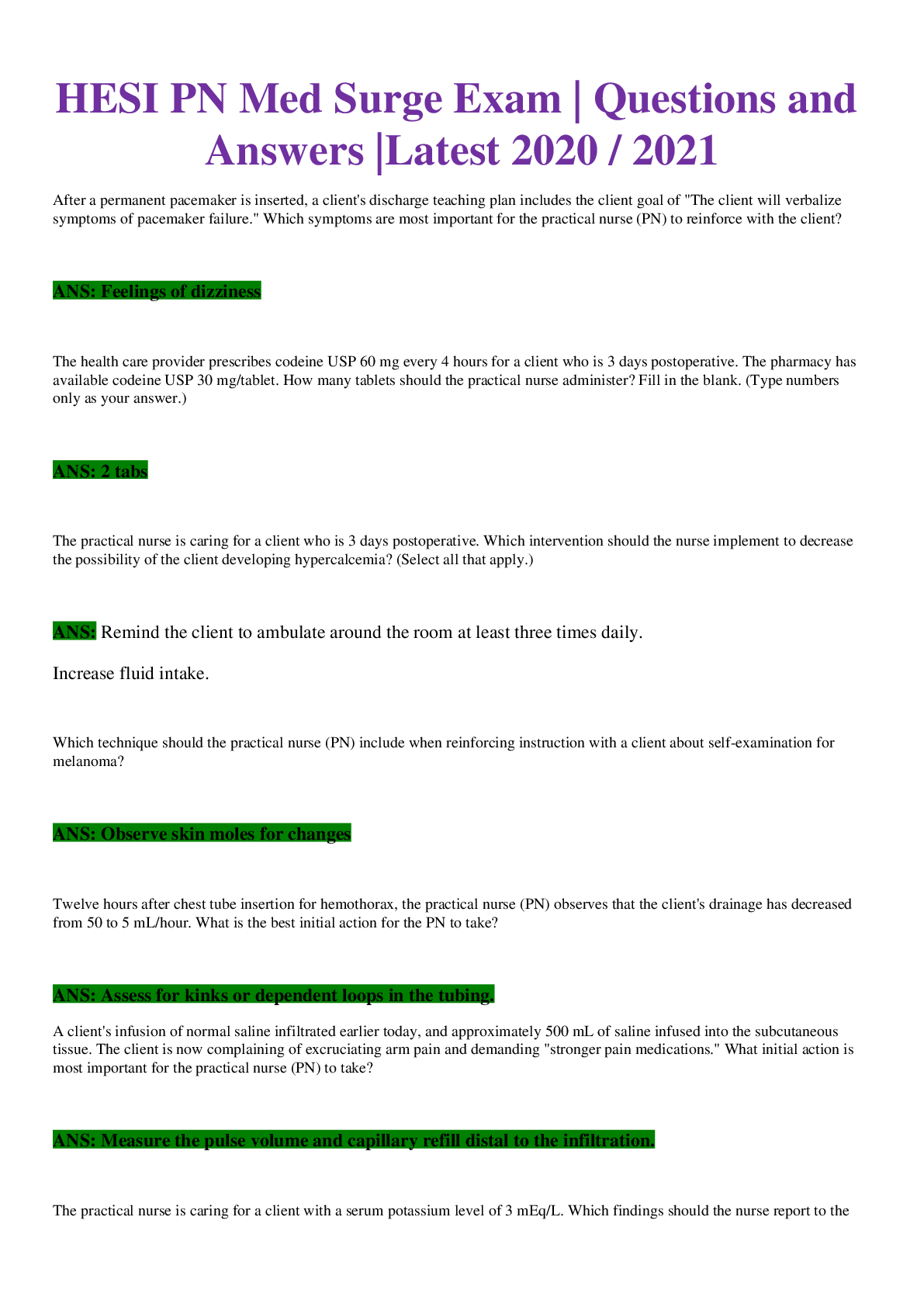

 Test Bank.png)
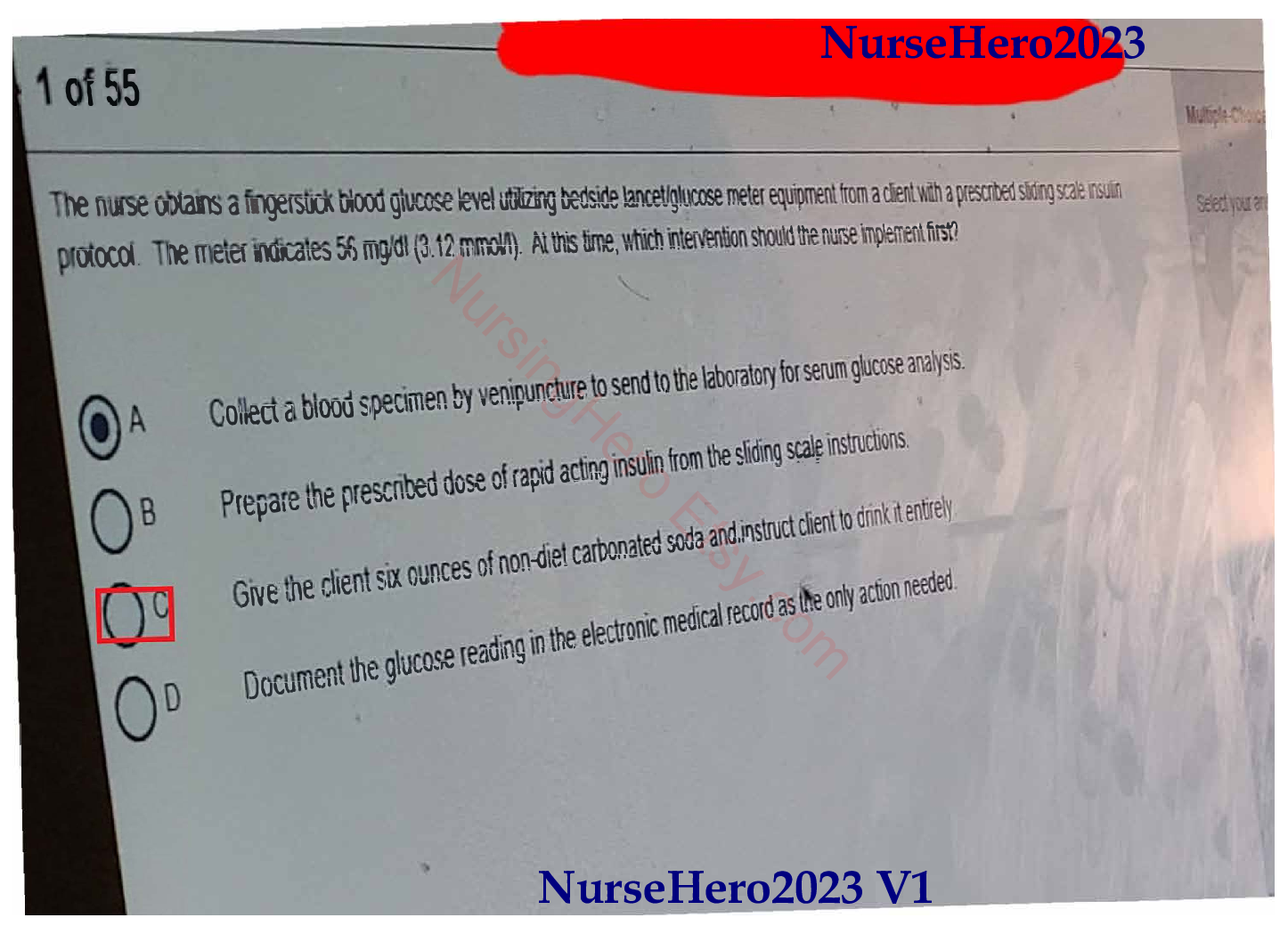

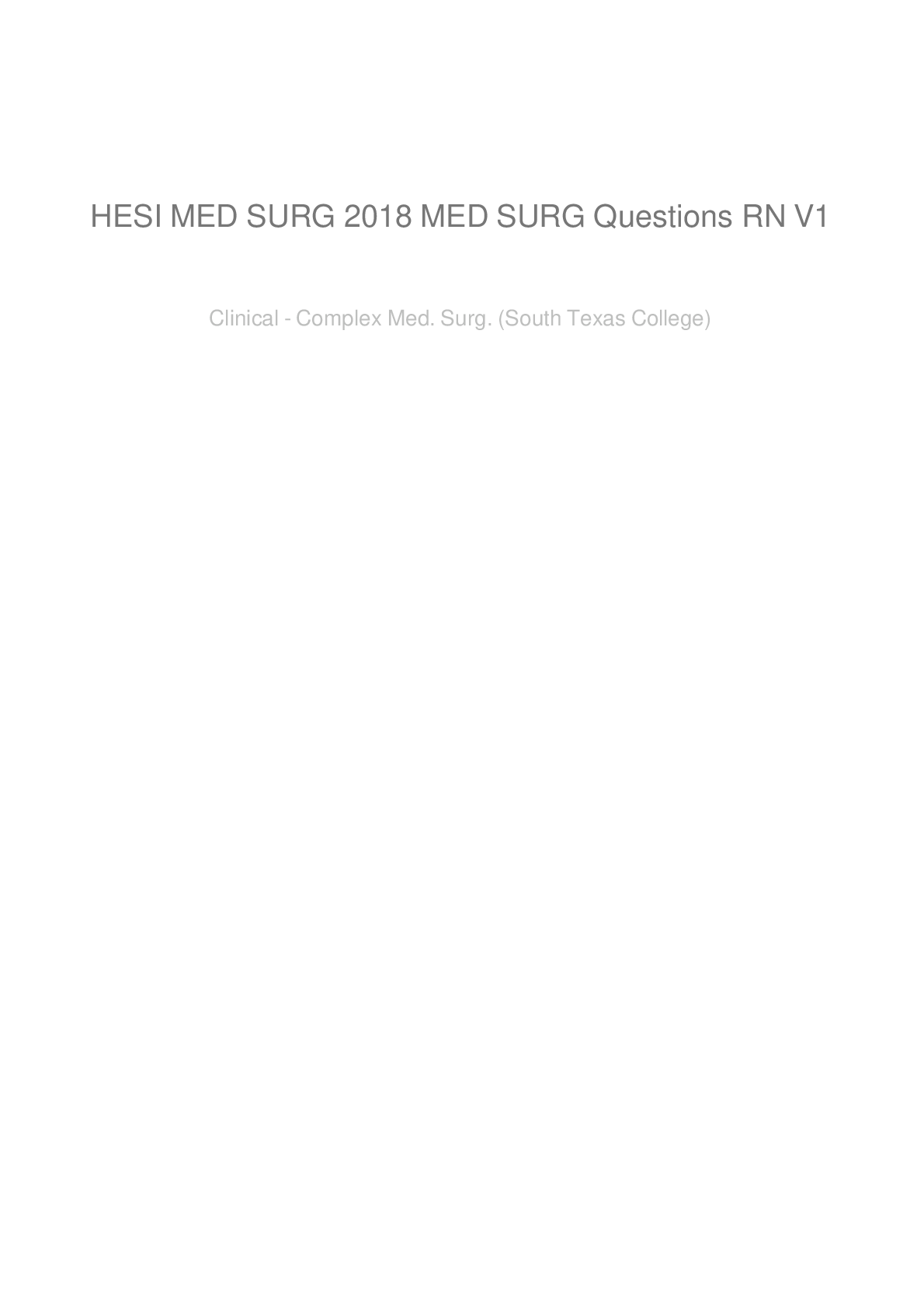
.png)
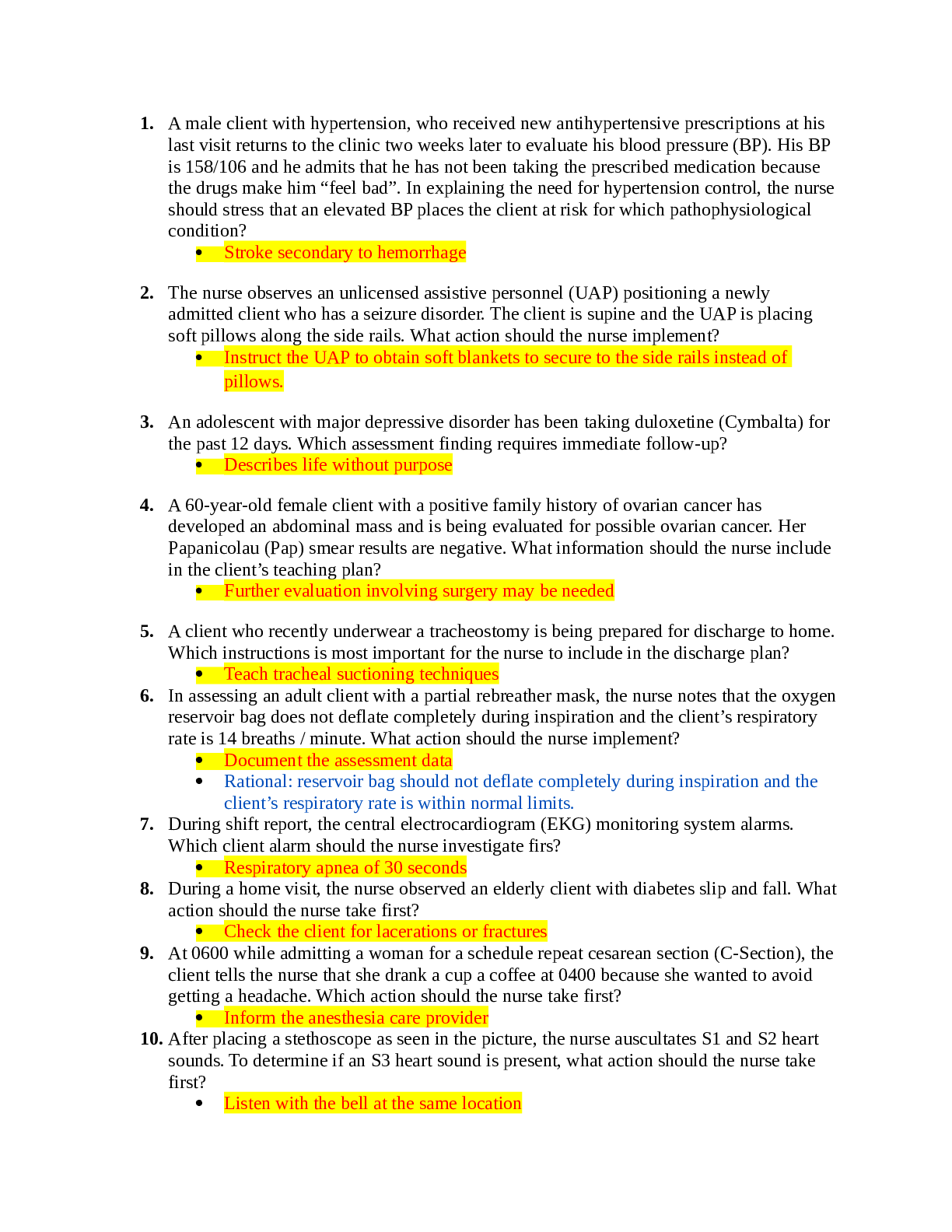
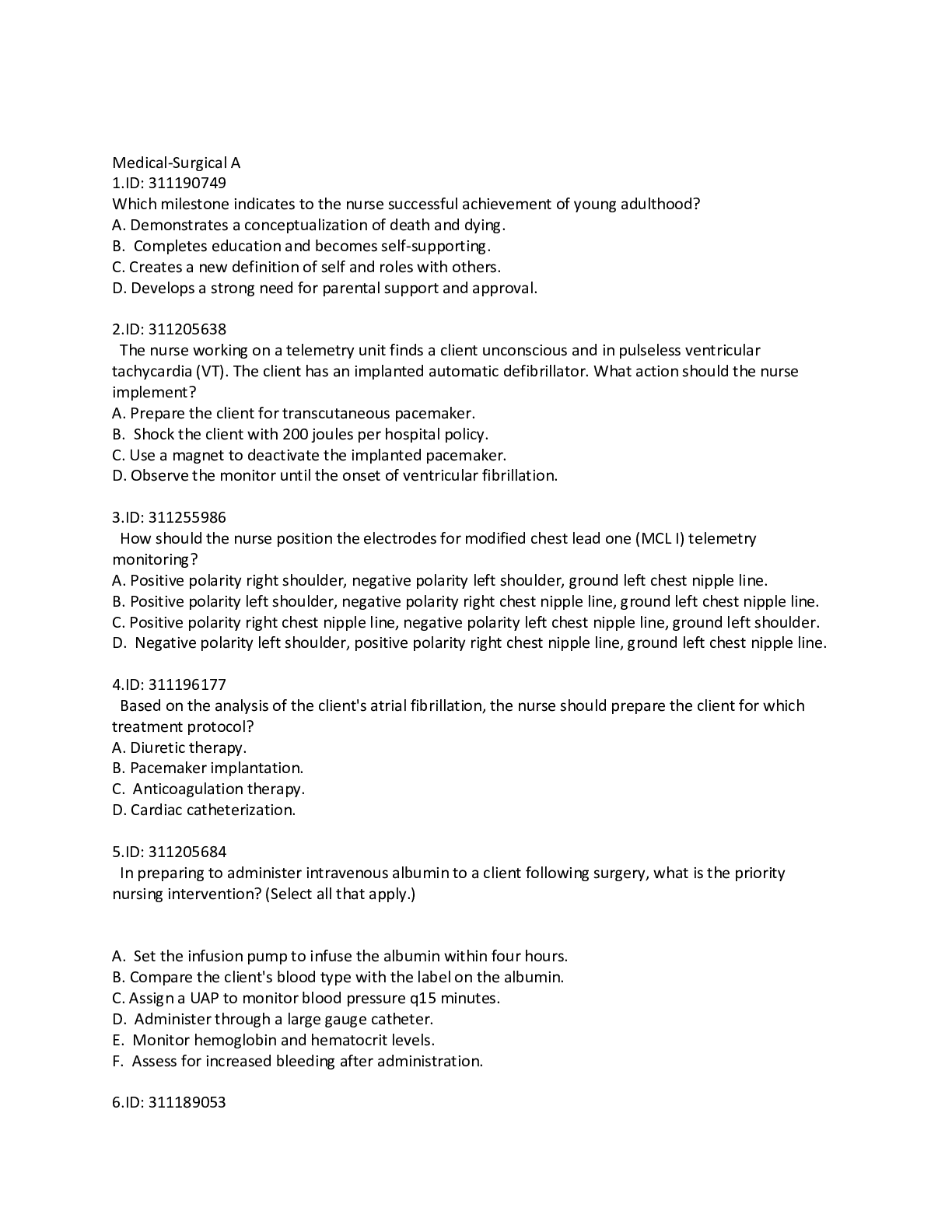
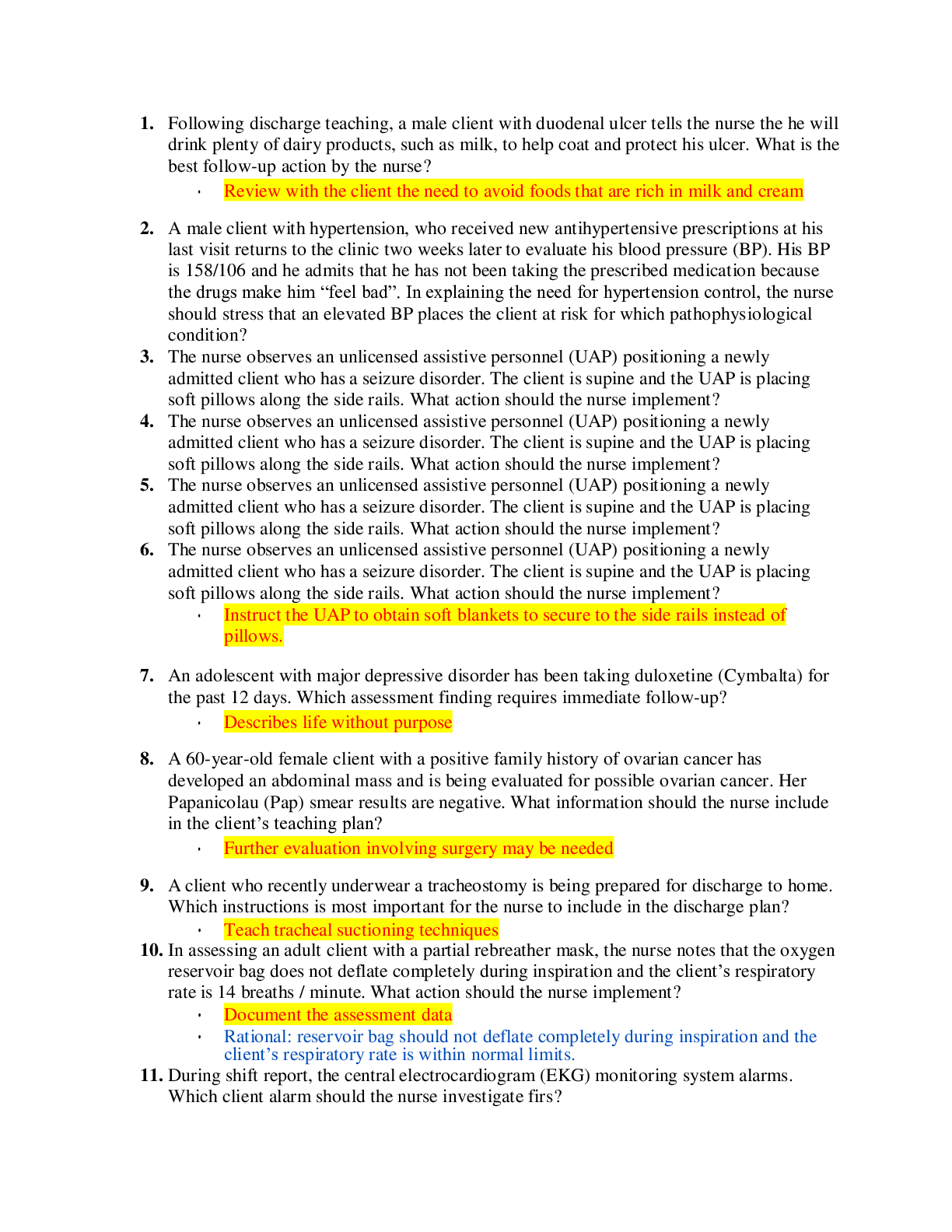


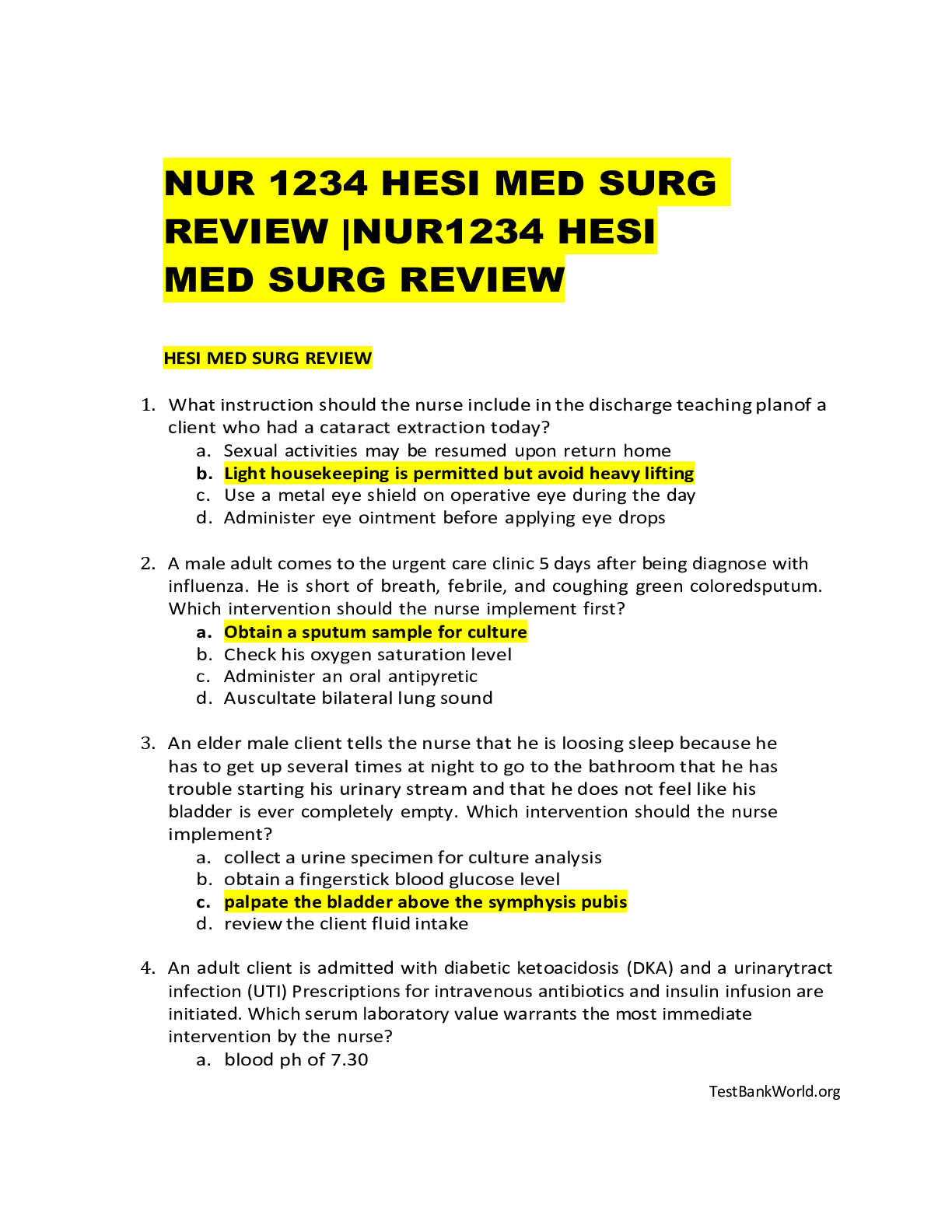
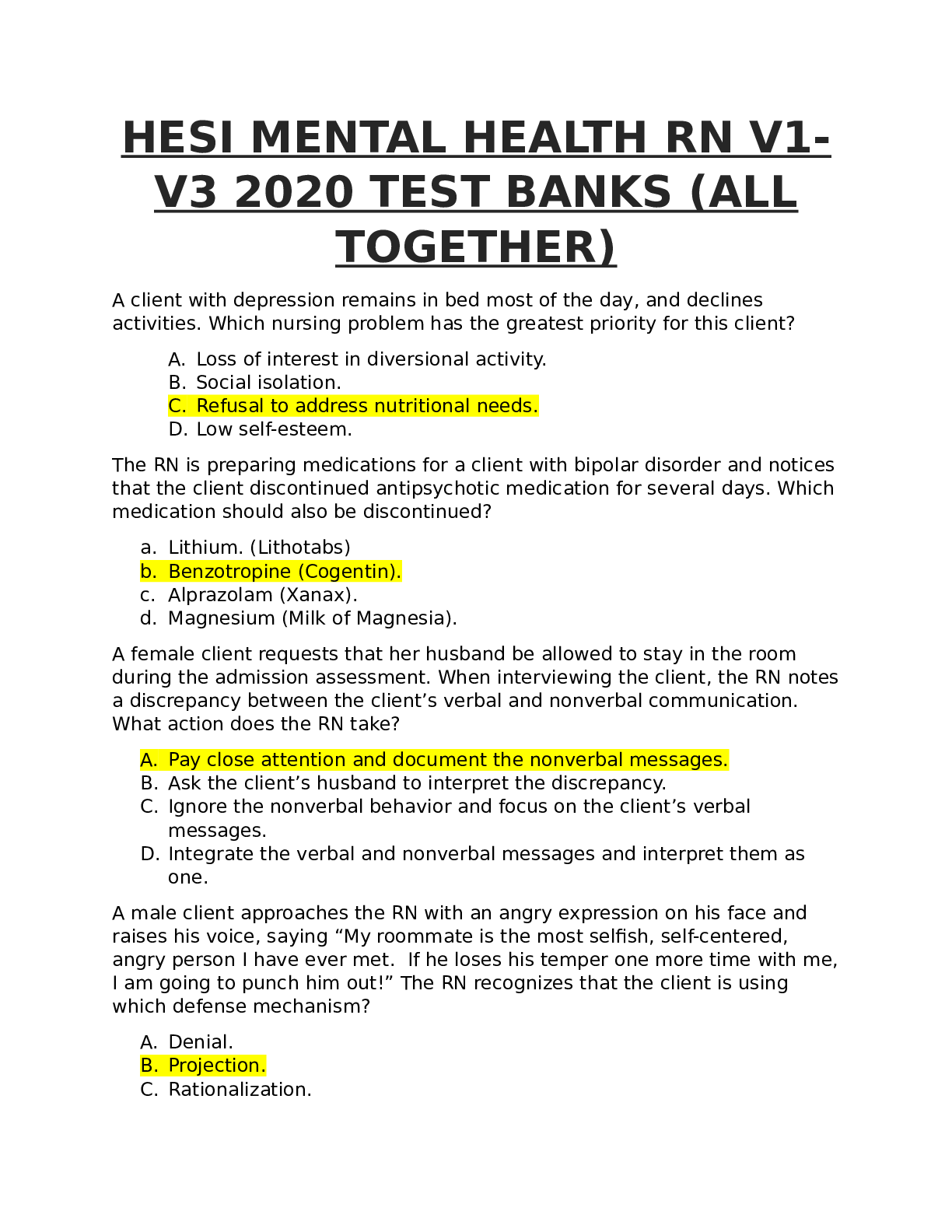
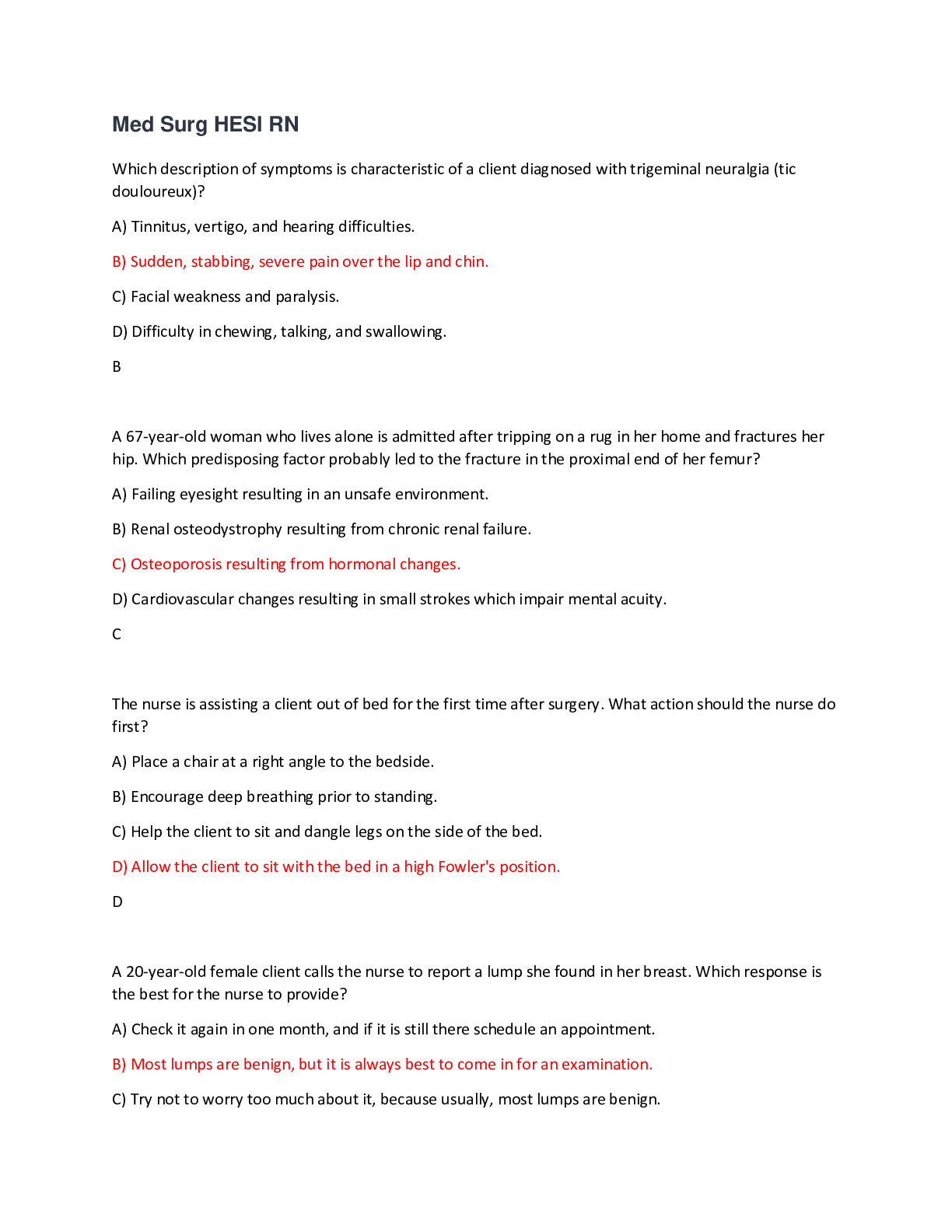
 Correct Study Guide, Download to Score A.png)
.png)


 Correct Study Guide, Download to Score A.png)

